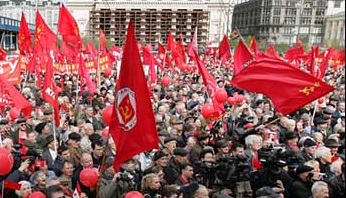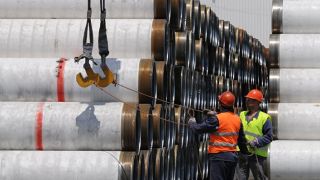The Communist Party of the Russian Federation (CPRF) failed to take advantage of the favorable social and economic situation for the left-wing forces and received fewer seats in the parliament after the recent elections to the State Duma. Such outcome of the elections is a reason to speak about the situation the left-wing movement has found itself in in the post-Soviet area.
The election results were painful especially for CPRF considering that theoretically the Russian left-wingers were to be in the vanguard of all the left-wing movements in the territory of the CIS. To recall, the leader of the Union of Coordination Councils of the Communist Party of the Soviet Union (CPSU), federation of the communist parties in the post-Soviet area considering itself the direct successor of the CPSU, is Gennady Zyuganov. The Communist Party of the Russian Federation may complain that the new system of elections with single-mandate constituencies eroded the electorate of the opposition parties, but the result has deteriorated dramatically as compared to the elections of 2011.
It is evident that the left-wing movement in the post-Soviet territory has been in a crisis for several years already. This year, Igor Dodon, the leader of the pro-Eurasian Party of Socialists of Moldova, who runs for president, has a real chance to correct the situation.
To that end, Dodon will need more than just majority of votes. It is much more important for him to “defend” the voting results. In 2011, Dodon failed to do it and lost the Chisinau mayor’s post to Romanian unionist Dorin Chirtoacă, as the administrative resources worked in his favor.
Second, it does not necessarily mean that coming to power Dodon will be waging a community-based domestic policy and pro-Eurasian foreign policy. Suffice it to recall the Moldavian communists led by former president Vladimir Voronin (who lost his post after riots of April 7, 2009 in Chisinau), the open satellites of comprador pro-European parties.
In Moldova, the left-wing forces have certain chances to come to power and have a significant number of seats in the parliament, while in other post-Soviet states, left-wingers are in worse situation.
In Belarus, the left-wing forces have only seven seats in the parliament and almost no political influence.
Last September, the Communist Party of Kazakhstan was banned.
Once influential Communist Party of Kyrgyzstan has lost almost all its voters refusing to run for the parliament last autumn.
In Uzbekistan, the Communist Party is clandestine.
The situation in neighboring Turkmenistan is not good either. The Communist Party has not been registered officially and its leader Serdar Rakhimov has been under arrest since 2002 for organizing an attempt to assassinate ex-president Saparmurat Niyazov.
In Tajikistan, the Communist Party operates under pressure of President Emomali Rahmon and has only two representatives in the parliament.
In the South Caucasus – Georgia, Armenia, and Azerbaijan – the communist parties are marginal and have no seats in the parliament.
The situation of the Communists in Ukraine is the most telling example of collapse of the communist movement. Yet in the late 20th and early 21st century, the Communist Party of Ukraine was the leading parliamentary force in the country until it was banned after the coup in 2014. Many activists of the middle and lower ranks were subjected to extrajudicial reprisals, while some of the leaders are still being persecuted.
The Communist Party of Ukraine (CPU) significantly contributed to the legitimization of the “Maidan regime” when it refused to vacate the seats in the parliament continuing to demonstrate bourgeois legality (such as voting for Alexander Turchynov taking the post of the so-called acting president). Second, CPU participated in both the presidential and parliamentary elections in conditions of continuous repressions against left-wingers, anti-fascist and pro-Russian forces. The Communists had to be at least in the vanguard of mass protests, if not fight along with guerillas against the Maidan regime, and not to try to fight for their activists and appeal to the state-controlled courts against the party bans.
Besides CPU, there is a range of left-wing parties in Ukraine (Union of the Left-wing Forces, Socialists, Progressive Socialist Party of Ukraine), but all are extremely marginalized and their rare protests are accompanied by attacks of radical-ultranationalists.
Quite recently, a veteran of the Ukrainian political field Alexander Moroz expressed desire to return to the political field registering a left-centrist party Truth and Justice. Ex-leader of “the passed-away” Socialist Party of Ukraine, Moroz is among those old politicians who managed to discredit severely the left movement in Ukraine. As politician, Moroz used to join both European integrators and pro-Russian representatives of big businesses.
There are two reasons why the left-wingers have found themselves in such situation in the post-Soviet area: unfavorable external conditions and their own mistakes.
As for the external environment, the wave of de-communization covered the post-Soviet area in 1990s when once secretaries of the Communist Party seized power and started demonizing the “criminal soviet past.” All this seriously affected the left-wing forces. It is evident that the ruling regime seeks to discredit the opponent political forces with programs telling about fair distribution of the social product.
In addition, the post-Soviet Communists became rather bourgeois supporting big businesses and “converting” the nostalgia for the Soviet times into real material benefits. Accumulating those benefits in their hands, the party leaderships have distanced themselves not only from the people but also from the middle and lower ranks, the true ideological activists of their own parties.
At the same time, the post-Soviet left-wingers lacked political ideas, using the outdated social and cultural ideas of the Soviet period that were no longer perceptive for the public two decades after the collapse of the Soviet Union.
The activity of the left-wing forces in the post-Soviet area have been very modest during the last 25 years. Nevertheless, the left-wingers able to ensure a fairer political and economic system are still demanded in the CIS. It appears that effective left forces will crystallize only when the ruling parties face political bankruptcy because of severe social, economic and political crises.
Igor Federovsky (Kiev) for EADaily

 Zelensky suddenly wanted to rest
Zelensky suddenly wanted to rest Zelensky's security guarantees have been removed — expert
Zelensky's security guarantees have been removed — expert Verdict Overdue, Belgian power, Arctic fox Zelensky: morning coffee with EADaily
Verdict Overdue, Belgian power, Arctic fox Zelensky: morning coffee with EADaily The Ukrainian Armed Forces have thrown foreign mercenaries and special forces of the GUR to Kupyansk
The Ukrainian Armed Forces have thrown foreign mercenaries and special forces of the GUR to Kupyansk It's no good! Trump is outraged by Kiev's attack on Putin's residence
It's no good! Trump is outraged by Kiev's attack on Putin's residence Trump was shocked to learn about Kiev's attack on Putin's residence — Ushakov
Trump was shocked to learn about Kiev's attack on Putin's residence — Ushakov